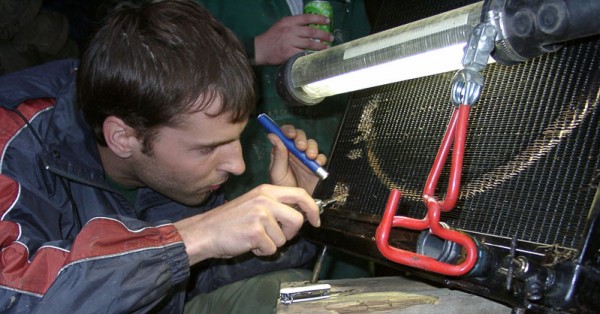There are specific problems that can ruin our radiator. As an example, anti-freeze solutions in the coolant could turn slightly acidic, if not replaced for four years. There could also be film residue in the radiator that can hold in heat and work like insulation. Radiator could also be affected by cracks on heater and radiator hoses. Leaks in head gasket and water pump seal may also slowly lower the coolant level. Sometimes, the radiator cooling fan could simply quit running. We should choose mechanics who can overcome these conditions and prevent radiator turn our busy day into a bad one.
In general, the radiator should work at 15lbs pressure. The pressure increases higher, especially when the radiator reaches the boiling point at 212 degrees. In a hot day, the radiator could run at 250 degrees, turning much of the coolant into steam. In general, the radiator should make sure that the coolant is always at a liquid state. This will allow the radiator to absorb a greater amount of heat from the engine and transfer it to the open air. This will keep the engine to run at an ideal operating level. All parts should be in top shape and the cooling system should be clean.
The radiator has heat-activated valve and it could control the flow of coolants that circulates through its system. When the coolant has reached a temperature above 212 degrees, it needs to move slower to get enough time to transfer the heat. Heat will be transferred to cooler areas from hotter parts. In this case, heat will be transferred to fins and tubes, eventually to the air that’s flowing around them. The combustion component of the engine could generate up to 500 degrees of heat and it needs a fully working cooling system to transfer heat to the outside. Unfortunately, there are problems that can affect radiator.
Electrolysis is something that could happen to our radiator. It is essentially a natural process, in which decay slowly eats holes in gasket and metal materials. Rubber seals will shrink and leaks will develop. When coolant breaks down and turns slightly acidic, the electrolysis process speeds up. Eventually, anti freeze will also turn acidic and tiny holes will start to appear. When the coolant is still in liquid form, dirt may still plug the small holes. However, when the car is driven and steam develops inside the radiator, the high pressure will force vapour to escape. This will lower the coolant level.
In just one hour, these small holes could allow up to 50 percent of the coolant to escape. This fact shows that we need to regularly replace the coolant and maintain the radiator. As coolant goes through the heating and cooling process repeatedly, it will start to breakdown. Not only it will turn acidic, sticky goo may also form and the whole cooling system will be coated. The film will act as insulator and the transfer of heat will be inhibited. The engine will run hotter and it will slowly kill our car. Acid and goo may harden inside the hoses, so they may remain inside the radiator, even if we replace the coolant.
